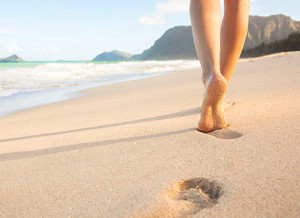
 Barefoot running has increased in popularity in recent years, and some experts believe it’s the way we should run. Dr. Irene Davis, a professor in physical medicine and rehabilitation at Harvard Medical School says that humans have evolved to run barefoot. The Raramuri people of northwest Mexico are famous for running barefoot for long distances. However, barefoot running does have its downsides and isn’t for everyone. Dr. Davis believes that running barefoot may prevent running injuries. Barefoot runners tend to land on the balls of their feet when they run, which causes less stress and impact on the foot. Running barefoot may also allow the runner to get a better feel for the surface and cause the foot to move more naturally. Another reported advantage of running barefoot is that foot muscles may become stronger and more durable. Finally, running barefoot forces us to be more observant to the surface we are running on and avoid small obstacles. If barefoot running sounds interesting, be sure to first ask a podiatrist if it is right for you.
Barefoot running has increased in popularity in recent years, and some experts believe it’s the way we should run. Dr. Irene Davis, a professor in physical medicine and rehabilitation at Harvard Medical School says that humans have evolved to run barefoot. The Raramuri people of northwest Mexico are famous for running barefoot for long distances. However, barefoot running does have its downsides and isn’t for everyone. Dr. Davis believes that running barefoot may prevent running injuries. Barefoot runners tend to land on the balls of their feet when they run, which causes less stress and impact on the foot. Running barefoot may also allow the runner to get a better feel for the surface and cause the foot to move more naturally. Another reported advantage of running barefoot is that foot muscles may become stronger and more durable. Finally, running barefoot forces us to be more observant to the surface we are running on and avoid small obstacles. If barefoot running sounds interesting, be sure to first ask a podiatrist if it is right for you.
Barefoot running has its own share of benefits and disadvantages. If you have any concerns about your feet or ankles, contact Dr. Todd Goldberg from Complete Family Foot Care Center. Our doctor will treat your foot and ankle needs.
Barefoot Running
The Impact of Barefoot Running
The Advantages of Barefoot Running
The Drawbacks of Barefoot Running
So, what can runners do to make barefoot running safe? It’s best to make a slow transition from running shoes to barefoot running. Once the feet begin to adjust, try walking, then jogging and gradually increasing the distance. Minimalist running shoes may also be an option.
If you have any questions please feel free to contact one of our office located in Littlestown, PA . We offer the newest diagnostic and treatment technologies for all your foot and ankle needs.